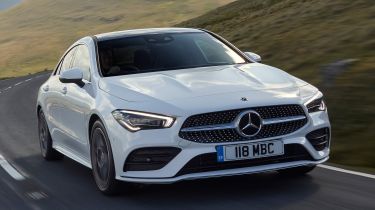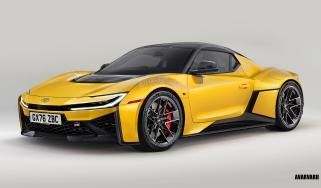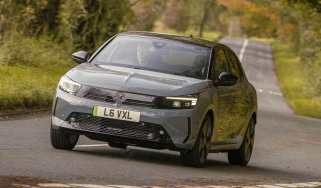Mercedes CLA review - Engines, performance and drive
The Mercedes CLA uses a wider track than the A-Class, but the differences to the car’s handling are marginal

On paper, the Mercedes CLA and the slightly frumpier A-Class Saloon draw certain parallels. However, under the skin, Merc’s engineers have made a few changes; the CLA’s track width has been stretched by 63mm at the front and 55mm at the back – in an effort to make it the sharper of the two to drive.
While the differences to most motorists will be marginal, the tweaks help the CLA stay flatter while cornering and make it the more engaging of the two to drive. This also helps make the CLA an accomplished motorway car; pick the diesel engine and you’ll have a car that challenges a C-Class for its grown-up feel, fuel economy and cruising prowess.
No matter which model you choose, the CLA responds keenly to your inputs, with very little body roll. Every UK car comes with a seven or eight-speed dual-clutch automatic gearbox, but every version we tried proved responsive enough not to need the steering wheel-mounted paddles. It’s good to know they’re there if you want them, however.
We’d recommend the entry-level CLA 180 rather than the more powerful CLA 200 if you’re after a petrol car. The two share their 1.3-litre turbocharged engine, and while both can feel strained under hard acceleration, the 180 is punchy enough. The (now discontinued) CLA 250 is expensive but smooth and powerful, giving the four-door coupe a surprising turn of pace. AMG models (both 35 and more powerful 45-badged versions) are also available.
More reviews
Car group tests
- Mercedes CLA vs Genesis G70: Germany faces Korea in our junior exec shoot-out
- BMW M235i Gran Coupe vs Mercedes-AMG CLA 35
In-depth reviews
Road tests
- New Mercedes CLA ride review: electric exec impresses from the passenger seat
- New Mercedes CLA 2023 review: an upmarket and stylish coupe
- New Mercedes-AMG CLA 45 S 2020 review
- New Mercedes-AMG CLA 35 Shooting Brake 2020 review
Used car tests
The diesel models will suit higher mileage drivers. Using the firm’s newer 2.0-litre diesel unit, these are much smoother than oil-burning Mercs of old. The diesel CLAs aren’t as quiet as the petrol models on the move, but customers covering big distances will be grateful for their dramatically superior fuel economy. There’s only one version (CLA 220 d) available at the moment, but with plenty of torque, it feels as quick and capable as the top-end petrol cars.
Mercedes also offers the CLA 250 e plug-in hybrid, with a powertrain consisting of a 1.3-litre petrol engine and 101bhp electric motor, which together produce 215bhp and 450Nm of torque.
Our test car rode on optional adaptive dampers that are reserved for sporty AMG 35 and 45 models in the UK, and while it rode very nicely, we've not tried a car on standard steel springs. Make sure you take one for a test drive before taking the plunge.
0-60mph acceleration and top speed
There are a load of petrol engines to choose from, but only one diesel CLA and no plug-in hybrid at the moment. The CLA 180 uses a 1.3-litre turbo petrol engine producing 134bhp; it’ll do 0-62mph in nine seconds, while the 161bhp CLA 200 trims this to 8.2 seconds. The differences are marginal, so we wouldn’t bother with the more powerful engine. Both feel a little strained under hard acceleration, but take things easy and they impressively quiet and refined.
Step up to the CLA 220, which uses a 187bhp 2.0-litre engine, and the 0-62mph time tumbles to seven seconds flat. This unit is also available with 4MATIC all-wheel drive, but adding that extra traction doesn’t affect performance. The CLA 250 e manages 0-62mph in 6.6 seconds, with a top speed of 146mph, while the CLA 250 is faster still (0-62 in 6.3 seconds), while the AMG 35 and AMG 45 S versions both complete the benchmark sprint in less than five seconds (4.9 and 4.0 seconds respectively).
The CLA 35 coupe and shooting brake estate share the same 2.0-litre, four-cylinder turbocharged engine as the A 35 hatchback and saloon. The powerful unit produces 302bhp and 400Nm of torque, and is mated to a seven-speed dual-clutch automatic transmission. Four-wheel drive is included as standard to help manage the extra shove. The range-topping CLA 45 S produces 415bhp from its 2.0-litre powerplant, delivering its power via an eight-speed dual-clutch gearbox.
Although both AMG derivatives are immensely quick, fast motorway cruising is probably what the CLA 35 does best, and particularly the more practical shooting brake model. The 45 features Mercedes' 4MATIC+ system, which is able to send a constantly variable amount of power to each wheel. It's designed to make the CLA 45 more adjustable, and also incorporates a new drift mode, which comes as standard on all UK models.
Mercedes has ensured that there’s plenty of front-end grip, while the tyres remain responsive to keen steering inputs. Pressing on the power out of a tight corner and you’ll feel it driving more from the rear than the front, too; in many ways it feels more like an old Mitsubishi Lancer Evo than its flat-footed predecessor.
If diesel is your fuel of choice, the only model available is the CLA 220 d. It’ll do 0-62mph in 7.1 seconds and hit 152mph flat out. With loads of torque (400Nm) it makes light work of brisk overtakes, without feeling rattly like old Merc diesels.











